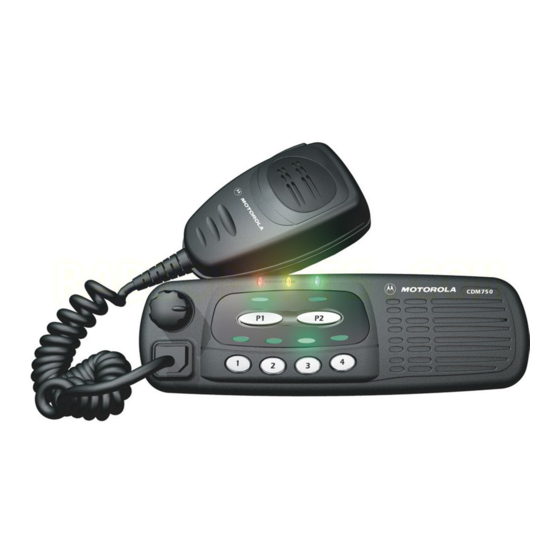Motorola CDM750 서비스 및 설치 매뉴얼 - 페이지 23
{카테고리_이름} Motorola CDM750에 대한 서비스 및 설치 매뉴얼을 온라인으로 검색하거나 PDF를 다운로드하세요. Motorola CDM750 32 페이지. Professional series
mobile radio
Motorola CDM750에 대해서도 마찬가지입니다: 사용자 설명서 (28 페이지)

Audio Paths
Transmit Audio
The mic source for base station transmit and intercom audio
is selected by programming switches and the headset sense
circuit consisting of Q1, Q2, and associated components. All
3 mic sources - headset, internal, and desk mic - are summed
through amplifier U1B to provide an 80mVAC reference sig-
nal at test point TP1. Base station mic audio is summed with
accessory mic audio and routed to the radio transmitter
through amplifier U1C.
Intercom/Parallel Transmit Audio
Some accessory devices are equipped to listen to intercom
audio on the transmit audio port, but other accessories
require that intercom audio be mixed with receiver audio.
The base station supports either type of accessory by proper
configuration of switches 2 and 3. If switch 2 is on, mic
audio from TP1 is gated through U4C and constant current
amplifier U2A/B to the accessory mic port (test point TP10).
If switch 3 is on, mic audio from TP1 is gated through U4B
to the accessory receive port at the output of amplifier U5.
Receiver Audio
External speaker audio from the radio is fed to the base sta-
tion speaker through amplifier U2D and speaker amp U6.
The level of this audio is controlled by the radio's volume
adjustment. Speaker audio is muted by signal SPMUTE (U6
pin 5) during PTT or during an accessory transmit, if switch
8 is on.
Constant level receiver audio from the radio (P3 pin 11) is
routed to the accessory device through amplifiers U2C and
U5. It is also routed to the headset earpiece through POT3
and amplifier U7A/B.
October, 2004
CDM Control Station
Theory of Operation
Digital functions
Mic Selection
The headset mic is enabled whenever headset PTT is active.
Otherwise, diode logic consisting of D15-D17 ensures that
when the headset is installed, the headset mic is selected
whenever the Intercom button is pressed and switch 7 is on.
The internal mic is enabled whenever local PTT is active.
Otherwise, diode logic consisting of D20-D26 ensures that if
switch 5 is on, the internal mic is active whenever the Inter-
com button is pressed. This logic also ensures that if switch
7 is on (to select the headset mic) but the headset is not
sensed, the local mic is enabled.
The desk mic is enabled whenever desk mic PTT is active.
Otherwise, diode logic consisting of D29-D30 ensures that if
switch 6 is on, the desk mic is active whenever the Intercom
button is pressed.
PTT
PTT from each source -- headset, desk mic, front panel but-
ton, and accessory - is OR'd through diodes D44-D46 at
inverter U13D. PTT is a closure through Q5. Q3 provides a
closure to mute the base station speaker when PTT is active.
Monitor
Monitor from each source - accessory, front panel button,
and desk mic - is OR'd through diodes D40-D42 at inverter
U13B. Monitor is a closure through Q4.
6880309N15-A
Section 4
4-1
